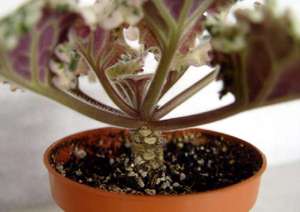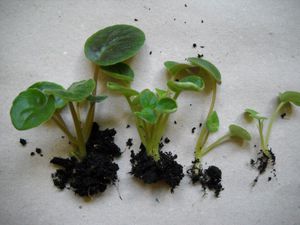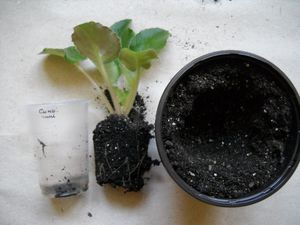All plants require transplanting or transplanting from time to time. And most often, the transplant is carried out due to the growth of the plant, when the regrown roots need a more voluminous pot. In cramped conditions, indoor plants stop growing, stop blooming and lose their decorative effect. Many beginner flower growers are wondering how to transplant violets at home. After all, Saintpaulia is a very delicate and fragile culture, from which one wants to achieve, in the end, beautiful flowering.
When to transplant an indoor flower?
This plant needs to be transplanted annually, it has a beneficial effect on his overall health. With time soil loses nutrientsrequired acidity and cakes. In addition, the transplant helps to hide the bare stem, helps to obtain a lush blooming rosette. How to determine when it is time to transplant a violet? There are certain signs:
- There is a white bloom on the surface of the soil, which indicates that the soil is devoid of air permeability and that it is oversaturated with mineral fertilizers.
- The earthen ball is tightly entwined with the root system of the flower. To make sure of this, the plant is removed from the container.
What time of year to transplant a violet? Saintpaulia is transplanted at any time of the year, except in winter, when the light flux is limited. Therefore, in winter, it is better not to disturb the violet, but to wait for a warm time. If you nevertheless decide to transplant in late autumn or winter, then the plant is necessary provide additional lightingconnecting lamps. If the summer is hot, then it is better to postpone the transplant, since the survival rate in such conditions gives a low percentage.
Can flowering Saintpaulia be transplanted? Many gardeners are interested in this question. Experts answer that transplanting is undesirable at the time of bud laying, since the violet can suspend the process that has begun. If the plant blooms, it means one thing: it feels great in this pot. Therefore, there is no need to rush. You should wait until the Saintpaulia fades, only then proceed to its transplant.
A flowering transplant is carried out only when absolutely necessary, in cases where immediate rescue of the flower is required. This procedure is carried out correctly - by the method of transshipment of an earthen coma. Before that, all the buds are cut off so as not to delay its early adaptation.
The plant for transplanting needs to be prepared. The earth ball is slightly moisturized in order to prevent root damage.
The earth should not stick to your hands, but it should not be overdried either. When wetting the substrate, avoid getting water on the leaves, which will save them from contamination during transplantation.
Transplanting violets at home
The main rules, in accordance with which it is required to transplant Saintpaulia, are the following:
 For planting violets, you should prepare a pot. It must be thoroughly rinsed, if the container has already been used, then it is cleaned of salt deposits.
For planting violets, you should prepare a pot. It must be thoroughly rinsed, if the container has already been used, then it is cleaned of salt deposits.- Each subsequent transplant should be carried out in a pot, the diameter of which is larger than the previous one.
- It is better to transplant a violet into a plastic container, since ceramic flowerpots quickly evaporate moisture.
- The plant is transplanted into a nutrient substrate that contains sand and peat. Since the violet needs good breathability and moisture permeability.
- The bottom must be drained from sphagnum moss or expanded clay.
- Correct planting of the plant should be done with the ground contact of the lower leaves.
- Violets are not watered immediately after planting in new soil. Cover with a clear plastic bag to increase humidity.
- In the process of transplanting, Saintpaulia is rejuvenated. For this, the roots and large leaves are cut a little.
Different transplant methods
 Today, you can transplant this indoor flower in several ways. For this need plastic pots, soil substrate and a little time.
Today, you can transplant this indoor flower in several ways. For this need plastic pots, soil substrate and a little time.
The most common reason for transplanting Saintpaulias at home is replacing the old potting mix with a new one. This procedure is carried out when the violet stops developing, has a bare stem or sour soil. Such a transplant requires a complete replacement of the soil, including removing it from the roots. This makes it possible to conduct a thorough examination of the root system; in case of its ill health, the removal of decayed and damaged parts is required. The violet is carefully removed from the pot, the soil, yellowed leaves, lethargic and dry peduncles are removed. Sections must be treated with charcoal powder.
If during transplantation it was necessary to remove many roots, the container is chosen one size smaller than the previous one.
The bottom of the pot is covered with expanded clay, after which form a hill of earth, on which spread, spreading the roots, violet. Then we add the soil to the very leaves. For better root compression with an earthen lump, lightly tap on the pot. After planting, the plant is watered no earlier than 24 hours later. After watering, when the mute earth subsides, you need to fill up the earth, in order to avoid exposing the stem.
Violet is transplanted at home and for partial soil change. This method is good for miniature varieties when a partial renewal of the substrate is sufficient. Such a transplant is carried out without damaging the root system in a larger pot. The transplant itself takes place in the same way as the previous method, however, the substrate is shaken off partially, without the need to disturb the earthen coma.
Transfer method
 Transplanting Saintpaulia by the transshipment method is carried out in the event of saving a flowering specimen or in order to plant the children. Also, this method is applicable when you need to transplant an overgrown flower rosette. Such a transplant implies complete preservation of the earthen coma... How to do it?
Transplanting Saintpaulia by the transshipment method is carried out in the event of saving a flowering specimen or in order to plant the children. Also, this method is applicable when you need to transplant an overgrown flower rosette. Such a transplant implies complete preservation of the earthen coma... How to do it?
A larger pot is covered with a layer of drainage, followed by a part of the fresh substrate. An old pot is inserted into this pot, aligned in the center. Soil is poured into the resulting free space between the pots, tap the container for better compaction. Then the old container is removed and a violet along with an earthen lump is placed in the recess formed from the previous pot. It is necessary to ensure that the surface of the new and old soil is at the same level. The transfer of Saintpaulia is over.
After this procedure, competent care is carried out, with which you can achieve full development and the exuberant bloom of violets.


